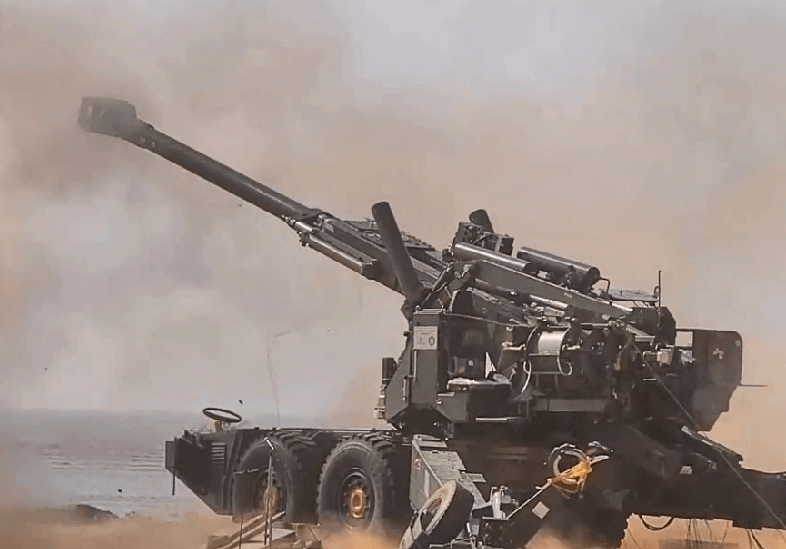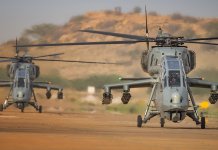One of the real successes of the ‘Made in India’ story in defense manufacturing has been the Advanced Towed Artillery Gun System (ATAGS). This 155-mm, 52-caliber artillery gun reportedly is undergoing the last stages of the trial, and could soon be inducted into the Indian Army.
Afghanistan, The Graveyards Of Super Powers – Will China Be Next In The Firing-Line?
In September 2012, the Ministry of Defence gave the green signal for this ambitious project. And by December 2016, ATAGS was made ready for trials.
Unlike most of the other indigenous defense ventures, be it the LCA Tejas, ALH Dhruva, MBT Arjuna, or nuclear submarine Arihant — all of which took many years or decades to become operational — the ATAGS could be regarded as unique because it is a world-class ‘Made in India’ product with more than 90 percent indigenous content that is certain to enhance the firepower of the army substantially.
It is not that the project did not have setbacks. Initially, the trials had to be delayed on account of the outbreak of the Covid-19 pandemic. After the development process was completed, trials in different weather conditions had to be undertaken.
However, during summer trials in Rajasthan, the bursting of a gun barrel raised questions about the efficacy of the weapon. Consequently, its induction into the army too, got slightly delayed.
This was not an isolated incident of an artillery gun facing trouble during trials. In fact, such incidents have been reported from all major countries, including the US, France, Germany, Israel during the development process of their artillery guns.

Even in India, the upgraded version of Dhanush and the US-made imported M777 ultra-light Howitzer had to endure such cases of barrel burst in the trial stages. In most cases, faulty ammunition was reported to be the reason behind the problem.
Subsequent technical investigations and rectifications led to relevant changes, and the ATAGS seems now ready to be part of the army’s big offensive weaponry. In fact, media reports suggest that the government has already given in-principle approval for the acquisition of 150 ATAGS for the Indian Army at an early date.
Some of the important developments associated with its progress are that it is an indigenous weapon system that is vital in the context of the army’s self-reliant rationalization plan in the contemporary cost-cutting scenario. ATAGS is also unique since it has turned out to be a great example of a successful public-private partnership.
The major defense laboratories involved in ATAGS development are the Defence Research Development Organisation’s (DRDO) Armament Research Development Establishment (ARDE) Pune, Defence Electronics Application Laboratory, Dehradun, and Centre for Artificial Intelligence and Robotics, Bengaluru along with major corporates like Bharat Forge, TATA Power SED, Ashok Leyland, and Cummins.
This success will spur more such ventures where defense PSUs and top corporate companies will together develop ambitious indigenous weaponry, saving the scarce forex for India and paving the way for their exports to other countries.
Other unique features of ATAGS include its ability to fire five-six rounds. All contemporary guns with other major militaries around the world can fire only three rounds. Also, its ability to allow loading of greater ammunition onto the target will make it difficult for enemy soldiers to take cover in the event of a real-time conflict.
Another best for ATAGS is its ability to fire the maximum range of 48 kilometers that no artillery gun in the world currently possesses. Experts have attributed this exceptional ability of ATAGS to its 25-liter chamber capacity whereas any comparable artillery gun only has a 23-liter chamber. Its magazine capacity for five-six rounds against the usual three-rounds has pushed its weight and thus requires a larger chamber.
The addition of battery engines has made the gun heavier; its mobility is one factor that initially raised some concerns. Yet the army has gladly accepted it on account of the strategic electrical system this gun is equipped with. The ATAGS has a world-class, digitally controlled communication system too.
In addition, from the deserts of Rajasthan to the high altitudes of Sikkim at -16 degrees Celsius, its trials have been proved very successful.
Since the entry of controversy-ridden Bofors into the Indian Army way back in the 1990s and subsequent blacklisting of the company, the army has been on the continuous lookout for a state-of-the-art 155-mm gun. It could prove to be critical and war-winner, especially in places like Line of Control (LoC), on the Pakistan border where the terrorists are ever ready to infiltrate into India. Targeting them with ATAGS could make life miserable for the enemy.
The importance of ATAGS is both strategic and financial. Strategically, this gun has a greater range, firepower, sophisticated control, and communication system, and advanced batteries. Its technical and operational superiority as compared to other contemporary artilleries around the world will provide the army with a huge operational advantage.
For quite some time, the army has had its eyes on acquiring such guns so that its firing capability gets enhanced, especially along the borders against both Pakistan and China.
When the ATAGS development was going full steam, the army even had dropped its plan to move ahead with a proposed order to Elbit Systems of Israel for importing 400 artillery guns. Hence, a lot depended upon the success of ATAGS, and the DRDO along with Indian corporates did not let the army down.
In the next decade, the army has plans to acquire almost 3,000 artillery guns of 155mm range to further enhance and consolidate its firepower. Even ATAGS does well, India would be able to save a huge amount of foreign exchange. Further, it could also form a significant part of the ambitious export plans of Indian weaponry around the world in due course.




